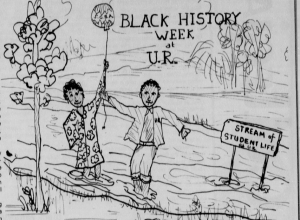 This cartoon accompanied an article entitled “SOBA Moves Toward the Mainstream.” Published in The Collegian on January 31, 1974, the piece concerns the Student Organization for Black Awareness (SOBA), a student group started in 1972 whose purpose, according to the article, was to “make black students an important part of campus life.” The cartoon shows a person in a UR emblazoned suit jacket leading another person holding a balloon labeled “S.O.B.A” into a body of water marked as the “Stream of Student Life at U.R.”. The image seems to rely on an assumption that black students at the university were not part of the norm. That acknowledgment of difference does not honor the diversity of experience black students brought to the university community but rather posits them as outsiders that needed to be led into the mainstream. If the author of the article and the creator of the cartoon had thought more carefully and more empathetically about the fact that simply because black students attended the university they should have been worthy of consideration as part of the mainstream. As full-time students who lived and attended classes, they were in effect part of mainstream university life.
This cartoon accompanied an article entitled “SOBA Moves Toward the Mainstream.” Published in The Collegian on January 31, 1974, the piece concerns the Student Organization for Black Awareness (SOBA), a student group started in 1972 whose purpose, according to the article, was to “make black students an important part of campus life.” The cartoon shows a person in a UR emblazoned suit jacket leading another person holding a balloon labeled “S.O.B.A” into a body of water marked as the “Stream of Student Life at U.R.”. The image seems to rely on an assumption that black students at the university were not part of the norm. That acknowledgment of difference does not honor the diversity of experience black students brought to the university community but rather posits them as outsiders that needed to be led into the mainstream. If the author of the article and the creator of the cartoon had thought more carefully and more empathetically about the fact that simply because black students attended the university they should have been worthy of consideration as part of the mainstream. As full-time students who lived and attended classes, they were in effect part of mainstream university life.
By creating and being part of a student organization SOBA members participated in a mainstream university activity. They went through the proper channels and had a faculty sponsor as well as a budget and a plan for future events just like other student groups on campus at the time. Even the way the founding members framed SOBA in the media was as a non-separatist group that wanted to be integral to all parts of the campus community. Furthermore, within the membership of SOBA, there were individuals who were part of other university entities that were more likely to be considered mainstream activity. For example, Stanley Davis, SOBA’s first president was a Richmond College Student Government Association senator and Norman Williams, the group’s treasurer, was on the track team.
I think the intent of the cartoon was to be welcoming and open-minded but the effect was tone deaf and showed how unfamiliar other students were with black students. The cartoon shows that there were those who were sympathetic to the plight of black students but the way they framed black students’ presence on campus was ultimately harmful because it made it seem like they were other. I understand how that framing might have fit better with a white student’s view of reality but by being full-time students engaged in the campus community in a number of ways it seems to me that black students were already integral to it. However, black students used this language as well which again I think was harmful to their purposes but the decision to adopt that language might have been strategic since they probably knew that others were apprehensive about their presence on campus.
